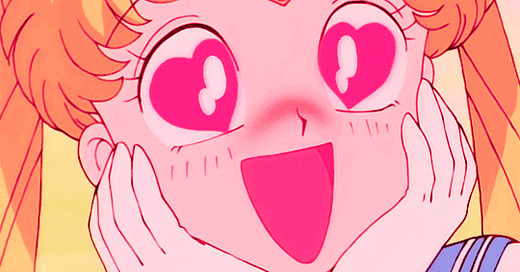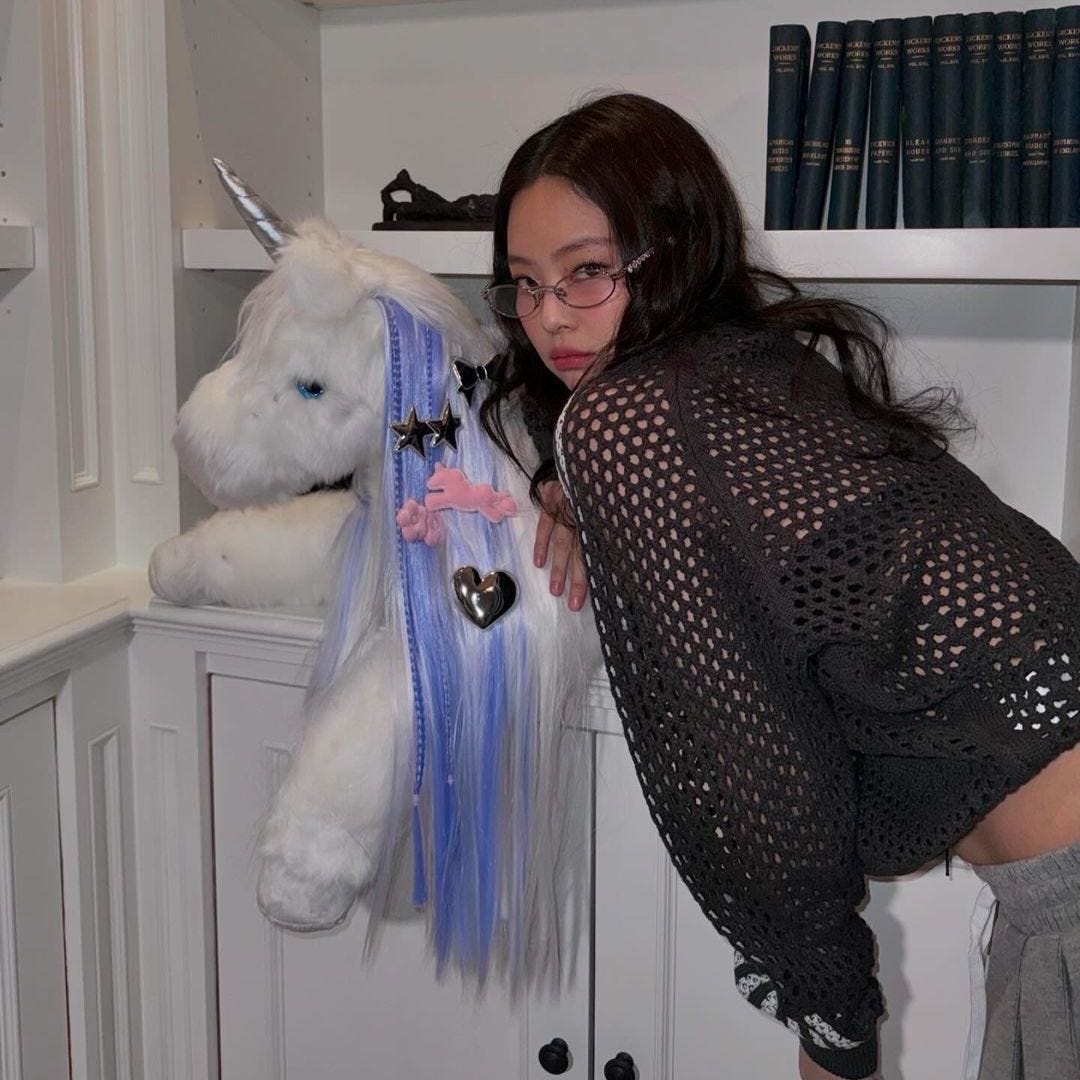If there’s anything that should catch your eye when you’re walking through Seoul, it should be the cute keychains dangling in twos, threes, fives (or even more!) from handbags, backpacks, jeans, belts, iPhones. Hello Kitty might find itself jostled rhythmically next to a Powerpuff Haerin or bumping heads with a perpetually smiling Choonsik. Even before Jane Birkin passed away and Miu Miu announced that “Birkinfication”—the act of dressing up your bag— is in for 2024, Seoulites already had a pack of miniature plushies bouncing off their backs and arms.
Where and how this sudden penchant for bag-kku surfaced isn’t clear. Notwithstanding this mysterious provenance, what is certain is that Seoulites have developed a Kirby-esque hunger for cuteness.
Last winter, Seoulites lined up in front of Everland Amusement Park at 7 AM, juggling hot packs, waiting for the gates to swing open at nine. What ensued was a race to see Fubao, the nation’s beloved panda, munch on an ever replenishing pile of bamboo leaves. The panda princess—now relocated to China—was oblivious to how people endured (another) two hours in front of her pen just to spend five minutes with her up-close. Talk about popularity.
The waiting saga continues into spring. Seoulites snaked around Dongdaemun Design Plaza (DDP) on the opening day of Hello Kitty’s 50th Anniversary Exhibition on April 13th. Rumor has it that the wait lasted three hours. My heartfelt respect goes out to those who braved the crowd this day.
And just two Wednesdays ago, Jennie released her most recent collaboration with Gentle Monster: Jentle Salon. It suffices to say that any combination of bejeweled capybaras, purple-haired unicorns and Jennie is more than enough to entice trend-savvy Seoulites to slide into the queue in front of Haus Dosan.
Having laid out four different events, unrelated to one another asides from a shared theme of cuteness, what naturally follows is a playful probe into why Seoulites dig cute things so much. Where does this predilection start? How are brands handling cuteness? Should we adopt cuteness? Thread a sparkly mental ribbon around these questions and hug them close as we shovel our way towards the bottom of cuteness.
Amnesic euphoria
It’s all instinctive. Or is it? A research by the University of Oxford suggests that Seoulites and humans at large are genetically programmed to respond positively to cuteness. Traits that we register as “cute”—large eyes, round face, stubby limbs, small nose—are all infantile in nature. Think Fubao, Hello Kitty or actual kittens. Scientists construe human reactions towards cuteness as a manifestation of maternal/paternal instinct. We’re codified to coo over and nurture things that look like they should be taken care of. This is how we’ve been able to stay alive this long as a species. Babies make us better people.
Already, we have part of the answer as to why we’re so drawn to cute things. However, the hypothesis above doesn’t make for a good explanation as to why people don’t just admire cuteness but indulge in it. The profound appreciation many of us have for cute things suggests that something else is at play. Something that goes beyond instinctual response. Something that resonates within a modern, increasingly babyless setting.
When we encounter something that strikes us as cute, our immediate reaction is to halt and stare. We fill our gaze with what’s in front of us. We study the object/person from above, below, left, right—a variety of angles—as if in doing so we’ll be able to see it better; by “it” I’m referring to cuteness. That oddly satisfying energy that leaves you with a soft ache. Cuteness is visible but hard to define. It’s this elusiveness—this sandlike translucence that slides right through your fingers—that makes the encounter with cuteness so tantalizing. There is never an “enough”.
What such intense studying or marveling evokes is a state of amnesic euphoria. Cuteness compels us to forget, at least for a moment, the reality we live in. In a split second, we’re transported into a state of delirious stupor where everything fades away, leaving only the object of interest and us levitating together on another plane. The only thing our brain registers is cuteness. Why we find the subject of interest so riveting is beyond comprehension. On a molecular level, what happens during this euphoric moment is the injection of dopamine into our brain. This dopamine rush is enough to push away any quotidian worries and induces a temporary amnesia that heals. Cuteness envelops us like a layer of cashmere, assuring us that, in this moment, we are safe. Cute things don’t hurt us. We’ve learned this collectively as a species through centuries of domesticating dogs, cats, horses, etc. It’s this disarming effect that leaves modern Seoulites craving for more. Cuteness has the power to excise people from daily travails and conjure for them, mentally, a safe space where they can engage in peace of mind.
Cuteness has the power to excise people from daily travails and conjure for them, mentally, a safe space where they can engage in peace of mind.
Breathe in, breathe out. Peace of mind is rare in a world that runs on competition. Most Seoulites, unless they practice meditation, don’t have the emotional bandwidth to check on themselves to see whether they’re running low on mindful energy. Seoulites are more used to comparative check-ups that usually culminate in binary conclusions i.e. “I graduated from a better university than person A, but (s)he has a higher paying job than me. I need to hustle”. Somewhat stimulating but not the best prep-talk. As such, Seoulites need a disruptant that diverts their attentions away from confidence-eroding thoughts and, instead, whisks them off into a state of amnesic euphoria where cuteness cushions them against the brutality of the world. Perhaps this is why some Seoulites sobbed uncontrollably on the day Fubao was escorted outside of Everland for her flight to China—they knew deep down that they were parting with more than just a cute panda. They were bidding farewell to the emotional oasis Fubao stood for.
Pocketable Beauty
Cuteness comforts. It uproots us from reality and plots us down on another world where we become enwrapped in amnesic euphoria. But is this all? There is still another angle through which we can approach this delectable topic: aesthetics. Cute things are highly aesthetic. It’s one of the reasons we’re so enamored with them. However, the beauty we see in cute objects is not the same beauty we feel when we stand in front of Boticelli’s The Birth of Venus. This difference is not one of superiority but of character. Cuteness possesses a covetability that is less pronounced in nature, great art, high literature—mediums through which beauty manifests in sublime iterations. Sublime beauty, as I like to coin it, is humbling. People fall silent at the sight of the Northern Lights, Monet’s “Water Lilies”, Gyeongju’s Seokguram Grotto. The awe that washes over us when we are in the presence of these monumental elements is almost spiritual. Sublime beauty reminds us of how small we are. We convert to a Carl Sagan-esque way of thinking that enables us to transcend our narrow perception of the world.

Cuteness, in contrast, epitomizes pocketable beauty. The objects and entities we describe as “cute” possess an intricacy that, when coupled with a minuscule size, inspire us with the urge to pocket it. When we run our hands over a Powerpuff NewJeans plushie or jingle a capybara pin from Jenni’s latest collab, we are acting on the desire to appropriate and claim this cuteness as ours. This impulse to appropriate, as self-interested as it is, is not motivated by just selfishness. Rather, it is an involuntary response and an admittance of the fact that most organisms lose their cuteness over time. In other words, cuteness is temporally scarce. It is a trait that becomes lost in the arcs of personal history, a rarity that stirs a wave of nostalgic yearning when we chance an encounter with it.
When we run our hands over a Powerpuff NewJeans plushie or jingle a capybara pin from Jenni’s latest collab, we are acting on the desire to appropriate and claim this cuteness as ours.

Therefore, the hype surrounding Jentle Salon, NewJeans’ collaboration with the Powerpuff Girls and Takashi Murakami, Hello Kitty’s 50th anniversary goods essentially reifies the human desire to identify as cute. The brands we tout as being “hip” or “cool” tap into this craving for cuteness, reinterpreting it in ways unique to their aesthetic; Gentle Monster references Jennie’s idiosyncratic penchant for capybaras while channeling a Y2K-style kitschness replete with ribbons and pearls; both the Powerpuff Girls and Takashi Murakami redraw NewJeans as a caricature of 90s nostalgia; Hello Kitty reaffirms cult status by replicating its original design across a multitude of consumable forms (i.e. stickers, coin purses, tote bags, etc.).
While not everything cute is necessarily “hip”, there is an element of coolness in being able to incorporate a trait normally limited to fictional characters and equally extraordinary artists into one’s lifestyle. People anticipate the attachment of keychains, the accessorizing of sunnies, the wearing of character-printed bags/T-shirts to have a positive rub-off effect that catapults their cute level to be on par with that of highly coveted celebrities. Sort of like how Mario supersizes when he “eats” a mushroom. We strive for a similar effect when we choose to associate ourselves with a specific object that registers as cute—what better way to amplify one’s charms than through the selective layering of adorable emblems? As such, the keychains Seoulites adorn their bags, airpods, iPhones with reflect at once an affinity for a specific character and a desire to be seen as representing a certain strain of cuteness. Hip-cute, 90s-cute, kawaii-cute. It’s all embodied in the objects they keep close to their bodies, an innocuous attempt to pocket a beauty that is ubiquitous yet rarely original.
Branding takeaway: sidle up forever
Sublime beauty edifies while pocketable beauty fortifies. The more commodifiable one out of the two is the latter. Brands understand that people want to enhance their attractiveness through instant, palpable change. This isn’t to say that brands aren’t aware of the impact a sublime experience has on a person. Such incidents are potent with life-changing energy. Nevertheless, the strategy most brands opt for is one of easy repeatability. Cuteness is lucrative from a business standpoint because it is inherently collectible. People are willing to pocket and consume variations of cuteness, much like how one upgrades a game character by equipping it with a different set of weapons, potions, wings, etc.
Within a contemporary context, cuteness is akin to modular armor. People can arbitrarily adopt an element of cuteness with full confidence that only the character’s endearing image is appropriated; the original story undergirding the character’s history is overwritten by the personal narrative of the gleeful adopter. In a sense, brands are purposely allowing fans to project their stories onto a character that is now both global and extremely personal. A spinoff of co-creation, this interaction enables brands to integrate themselves into a follower’s present and future without friction.
Whether it’s the Powerpuff Girls, Jentle capybaras or Sanrio, pocketable cuteness imbues us with the confidence that our fortified covetability inspires others to be kinder, sweeter, better towards us.







![얼리버드] 헬로키티 50주년 특별전 - 감도 깊은 취향 셀렉트샵 29CM 얼리버드] 헬로키티 50주년 특별전 - 감도 깊은 취향 셀렉트샵 29CM](https://substackcdn.com/image/fetch/$s_!U5mz!,w_1456,c_limit,f_auto,q_auto:good,fl_progressive:steep/https%3A%2F%2Fsubstack-post-media.s3.amazonaws.com%2Fpublic%2Fimages%2F82224b70-f469-4498-b97c-5632c8856e4f_700x700.jpeg)


